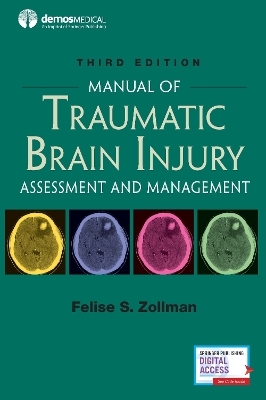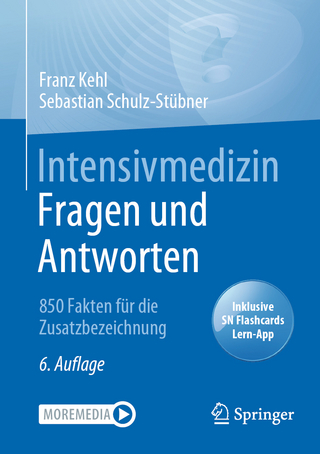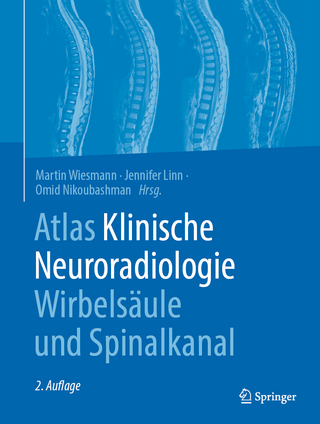
Manual of Traumatic Brain Injury
Springer Publishing Co Inc (Verlag)
978-0-8261-4767-7 (ISBN)
- Titel z.Zt. nicht lieferbar
- Versandkostenfrei innerhalb Deutschlands
- Auch auf Rechnung
- Verfügbarkeit in der Filiale vor Ort prüfen
- Artikel merken
Each chapter includes boxed Key Points which underscore major clinical takeaways, Study Questions to facilitate self-assessment and further emphasize core chapter content, and an Additional Reading list for a deeper dive into chapter concepts. Significant updates incorporating recent advancements in the field, combined with the clinical acumen of its experienced contributors, make this third edition the essential manual for healthcare professionals caring for individuals with traumatic brain injury.
Key Features:
Succinct format encourages targeted access to key clinical information
Completely revised and updated third edition reflects current state of the art advancements
Added content areas such as a new chapter dedicated to substance abuse and TBI expand the scope of material addressed
Newly added multiple choice Study Questions in each chapter facilitate self-assessment of mastery of chapter material
Purchase includes digital access for use on most mobile devices or computers
Felise S. Zollman, MD, Co-Project Director, Midwest Regional Traumatic Brain Injury Model System Center, Attending Physician, Brain Injury and Rehabilitation Program, Rehabilitation Institute of Chicago, Assistant Professor, Departments of Physical Medicine and Rehabilitation & Neurology, Northwestern University Feinberg School of Medicine, Chicago, IL
Contributors
Preface
Part I: Core Concepts
Chapter 1. Traumatic Brain Injury: Definitions and Nomenclature by Kristine O'Phelan and Yazeed Alolayan
Chapter 2. Essential Concepts in TBI Biomechanics and Neuropathology by Michelle A. LaPlaca, Susan S. Margulies, and David W. Wright
Chapter 3. Characterization of Traumatic Brain Injury Severity by Lisa A. Lombard and F. Scott Winstanley
Chapter 4. Epidemiology of Traumatic Brain Injury by Rugaieh Abaza and Marie Crandall
Chapter 5. Injury Prevention by Arlene I. Greenspan, Matthew Breiding, and Christopher R. Harper
Part II: Mild Traumatic Brain Injury
Chapter 6. Concussion and Mild Traumatic Brain Injury: Definitions, Distinctions, and Diagnostic Criteria by Noah D. Silverberg, Rael T. Lange, and Grant L. Iverson
Chapter 7. Mild Traumatic Brain Injury: Initial Medical Evaluation and Management by Micelle J. Haydel
Chapter 8. The Natural History of Mild Traumatic Brain Injury by Grant L. Iverson, Douglas P. Terry, Rael T. Lange, and Noah D. Silverberg
Chapter 9. Sport-Related Concussion I: Injury Prevention and Initial Assessment by Philip H. Montenigro and Robert C. Cantu
Chapter 10. Sport-Related Concussion II: Managing the Injured Athlete and Return-to-Play Decision Making by Mary Alexis Iaccarino and Ross Zafonte
Chapter 11. Second Impact Syndrome by Gary Goldberg and William A. Robbins
Chapter 12. Structural and Functional Brain Imaging in Mild Traumatic Brain Injury by Jeffrey David Lewine
Chapter 13. Selected Somatic Disorders Associated With Mild Traumatic Brain Injury: Fatigue, Dizziness and Balance Impairment, and Whiplash Injury by Elie Elovic and Michael Henrie
Chapter 14. Cognition in Mild Traumatic Brain Injury: Neuropsychological Assessment by Eric B. Larson and Heather G. Belanger
Chapter 15. Postconcussion Syndrome: Diagnostic Characteristics and Clinical Manifestations by Erica Bellamkonda and Felise S. Zollman
Chapter 16. Postconcussion Syndrome: Symptom Management by William C. Walker and Richard D. Kunz
Chapter 17. Confounding Factors in Postconcussive Disorders by Nathan D. Zasler
Chapter 18. Recognizing Manifestations of Posttraumatic Stress Disorder in Patients With Traumatic Brain Injury by Eric B. Larson and Heather G. Belanger
Part III: Moderate to Severe Traumatic Brain Injury
Chapter 19. Field Management: Prehospital Care by Joshua B. Gaither
Chapter 20. Emergency Department Management and Initial Trauma Care Considerations by Matthew Kochuba and Marie Crandall
Chapter 21. Imaging in Moderate to Severe Traumatic Brain Injury by David N. Alexander and Ellen C. Wong
Chapter 22. Neurosurgical Management of Skull Fractures and Intracranial Hemorrhage by Joshua M. Rosenow
Chapter 23. The Neurointensive Care Unit: Intracranial Pressure and Cerebral Oxygenation by Brandon A. Francis and Matthew B. Maas
Chapter 24. Anoxia Complicating TBI by Gary Goldberg
Chapter 25. The Role of Neuroprotective Interventions in Traumatic Brain Injury by Jacob R. Joseph and David O. Okonkwo
Chapter 26. Nutritional Considerations by Melissa A. Nestor and Barbara Magnuson
Chapter 27. Initial Rehabilitation Interventions in the Acute Hospital Setting and Transitioning to the Next Level of Care by Brian D. Greenwald, Christine Greiss, and Mina Gayed
Chapter 28. Disorders of Consciousness by Brian D. Greenwald and Matthew D. Moore
Chapter 29. The Role of Specialized Brain Injury Units in the Rehabilitation Process by Billie A. Schultz
Chapter 30. Rehabilitation Nursing by Ann S. Bines and Lindsay Hong
Chapter 31. Physical Therapy: Mobility, Transfers, and Ambulation; Vestibular Rehabilitation by Catherine Burress Kestner
Chapter 32. Occupational Therapy: Activities of Daily Living, Driving, and Community Reintegration by Anne W. Hunt and Jennifer Fleming
Chapter 33. Speech Therapy: Dysphagia and Cognitive Communication Impairments by Sarah Taylor
Chapter 34. Neuro-Visual Processing Rehabilitation for Visual Dysfunction by William V. Padula and Jonathan Jenness
Chapter 35. Cognitive Impairment: Characterization and Management by Eric B. Larson
Chapter 36. Behavioral Impairment: Recognition and Management by Cynthia L. Beaulieu, Tracy Shannon, and Jennifer Bogner
Chapter 37. Rational Neuropharmacology in Traumatic Brain Injury by Durga Roy, Sandeep Vaishnavi, and Vani A. Rao
Chapter 38. Pain Management in Persons With Traumatic Brain Injury by Nathan D. Zasler
Chapter 39. Assistive Technology in Traumatic Brain Injury by Kurt L. Johnson and Mark Harniss
Chapter 40. Practical Guidelines for Prognostication After Traumatic Brain Injury by Sunil Kothari and Bei Zhang
Chapter 41. Sexuality After Traumatic Brain Injury by Angelle M. Sander
Chapter 42. Assessment of Decision-Making Capacity by Eric S. Swirsky and Kristi L. Kirschner
Chapter 43. Community Integration by Dmitry Esterov, Julie Witkowski, and Thomas Bergquist
Part IV: Complications and Long-Term Sequelae
Chapter 44. Cranial Nerve Palsies by Flora M. Hammond and Sheryl D. Katta-Charles
Chapter 45. Hydrocephalus by David F. Long and Mithra B. Maneyapanda
Chapter 46. Posttraumatic Seizures by Kan Ding and Ramon Diaz-Arrastia
Chapter 47. Heterotopic Ossification by Nora Cullen
Chapter 48. The Management of Endocrine Dysfunction in Traumatic Brain Injury by Nigel Glynn, Lucy-Ann Behan, and Amar Agha
Chapter 49. Autonomic Dysfunction by Cherina Cyborski
Chapter 50. Movement Disorders by Bruno S. Subbarao and Blessen C. Eapen
Chapter 51. Spasticity in Traumatic Brain Injury by Bonny S. Wong, Mary Alexis Iaccarino, and Ross Zafonte
Chapter 52. Screening for Emotional Distress After Traumatic Brain Injury by Angelle M. Sander
Chapter 53. Sleep Disturbances by Felise S. Zollman and Eric B. Larson
Chapter 54. Chronic Neuropsychiatric Sequelae I: Mood Disorders by Hazem Shahin and Ricardo E. Jorge
Chapter 55. Chronic Neuropsychiatric Sequelae II: Behavioral Disturbances by Jason Krellman and Theodore Tsaousides
Chapter 56. Cumulative Effects of Repeated Mild Traumatic Brain Injury and Chronic Traumatic Encephalopathy by Philip H. Montenigro and Robert C. Cantu
Chapter 57. Posttraumatic Headache by Thomas K. Watanabe
Chapter 58. Neurovascular Complications After Nonpenetrating Brain Injury by Sunil Kothari and Bei Zhang
Part V: Special Considerations and Traumatic Brain Injury Resources
Chapter 59. Pediatric Considerations in Traumatic Brain Injury Care by Sharief Taraman, Rachel Pearson, and Jonathan Romain
Chapter 60. Special Considerations in Caring for the Workers' Compensation Patient by Felise S. Zollman
Chapter 61. Developing a Life Care Plan by Roger O. Weed and Debra E. Berens
Chapter 62. Traumatic Brain Injury in a Forensic Context by Jerry J. Sweet, Kristen M. Klipfel, and Laura M. Benson
Chapter 63. Alcohol Misuse and Traumatic Brain Injury by Randi Dubiel and John D. Corrigan
Chapter 64. Substance Abuse and Traumatic Brain Injury by Randi Dubiel and Joshua M. Masino
Chapter 65. Ethical Considerations by Teresa A. Savage and Debjani Mukherjee
Chapter 66. Special Considerations for Military Personnel: Unique Aspects of Blast Injury by Hunaid Hasan and Michael S. Jaffee
Chapter 67. Treatment and Rehabilitation Services for Mild to Moderate Traumatic Brain Injury in the Military by Amy Y. Hao, Blessen C. Eapen, and Amy O. Bowles
Chapter 68. Management of Traumatic Brain Injury in the Older Adult by David X. Cifu, Blessen C. Eapen, and Carlos A. Jaramillo
Chapter 69. Complementary and Alternative Medicine in Traumatic Brain Injury by Felise S. Zollman
Chapter 70. Return to Work Following Traumatic Brain Injury by Nancy H. Hsu
Chapter 71. Resources for Traumatic Brain Injury Survivors and Caregivers by Sarah Taylor
Chapter 72. Living With Traumatic Brain Injury: From a Survivor's Perspective by Jennifer Field
| Erscheinungsdatum | 24.02.2021 |
|---|---|
| Zusatzinfo | 50 illustrations |
| Verlagsort | New York |
| Sprache | englisch |
| Maße | 152 x 229 mm |
| Gewicht | 808 g |
| Themenwelt | Medizinische Fachgebiete ► Chirurgie ► Neurochirurgie |
| Medizin / Pharmazie ► Medizinische Fachgebiete ► Neurologie | |
| Medizin / Pharmazie ► Physiotherapie / Ergotherapie ► Rehabilitation | |
| ISBN-10 | 0-8261-4767-4 / 0826147674 |
| ISBN-13 | 978-0-8261-4767-7 / 9780826147677 |
| Zustand | Neuware |
| Informationen gemäß Produktsicherheitsverordnung (GPSR) | |
| Haben Sie eine Frage zum Produkt? |
aus dem Bereich


